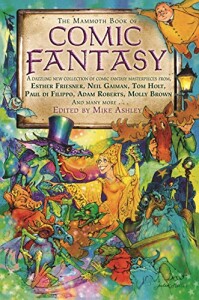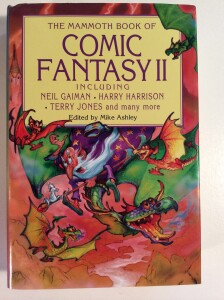 I’ll admit, a couple of years ago I knew little about the genre of “comic fantasy.” It hadn’t really even occurred to me that there might be such a thing, though I probably would have been able to come up with some examples if I’d ever bothered to stop and think about it. In fact, as Mike Ashley, editor of the two-volume The Mammoth Book of Comic Fantasy explains, the humourous and the fantastic have had a long history together. He cites Jonathon Swift’s satirical “Gulliver’s Travels” as one example, dating back to the early 18th century, and that’s not the earliest by a long shot.
I’ll admit, a couple of years ago I knew little about the genre of “comic fantasy.” It hadn’t really even occurred to me that there might be such a thing, though I probably would have been able to come up with some examples if I’d ever bothered to stop and think about it. In fact, as Mike Ashley, editor of the two-volume The Mammoth Book of Comic Fantasy explains, the humourous and the fantastic have had a long history together. He cites Jonathon Swift’s satirical “Gulliver’s Travels” as one example, dating back to the early 18th century, and that’s not the earliest by a long shot.
Now, the difficult thing about reviewing this particular type of collection is that there are as many authors as stories: Harry Turtledove, Jane Yolen, Neil Gaiman, Terry Pratchett, Esther M. Friesner, Gardner Dozois, Tom Holt, and that’s just a smattering. With the wide range of styles, I certainly can’t guarantee that you’ll like every offering in either anthology – and in fact, Ashley says much the same thing in the forward of the first book. But he also says that he’d be surprised if you didn’t find most of them entertaining, and I’m inclined to agree.
The setup is the same for both books. Each story has a short paragraph preceding it, by way of introduction. I appreciate this as they often contain interesting or useful information, and it’s nice to hear Ashley’s thoughts throughout the book, including the reasons for the choices he’s made. Most book editors do a quick introduction and that’s it. Ashley’s clearly no slack editor.
He also has a limited grouping system throughout. In the first Mammoth Book of Comic Fantasy, the first 10 stories fall under no particular heading, but then we have: A Bunch of Fairy Tales; A Pair of Lovecraftians; A Cocoon of Oldies; and A Quiver of Spooks, which is the last sub-heading, though I couldn’t say how many of the stories at the end of the book are supposed to fall under it.
The styles are varied. Some are sharply satirical, others are silly and irreverent, still others are dark and morbid. Some are new takes on old fantasy stand-bys. Some forgo the parody and come up with something entirely different. I can’t say what you’ll like and what you won’t like, but I do expect there’s something for everyone here.
Highlights of the first book (for me) include: “The Distressing Damsel,” a rather humourous take on various princess myths; “Looking-Glass Land,” an excerpt from Lewis Carroll’s second Alice story; “The Return of Max Kearny,” which follows one of the cases of a paranormal investigator; “A Fortnight of Miracles,” a novella length adventure involving a cursed knight and the sharp-witted magician who tries to solve the mystery of his malady; “The Return of Mad Santa,” which boasts a provocative title I defy you to resist; and “Been a Long, Long Time,” which poses the question of just how long it would take for a monkey to randomly type out the works of Shakespeare. But this is only a small sampling, and in fact, each story in this collection has something to offer.
 The second volume offers a brand new cocktail mix of craziness. A few alumni contributors from the first book return with new offerings, while many new names are here as well. The format is the same as in the first, and there are headings for groups of stories with common themes, including: A Shiver of Elves; Two Tall Tales; An Intrusion of Aliens; A Doubling of Dragons; Some Wise Advice; A Gaggle of Gangsters; A Fancy of Fairy Tales; and An Inkling of Imps. There are still plenty of uncategorized stories – and indeed, many of the groupings’ common threads are tenuous, at best – but with the quantity of individual works here, it’s helpful to have the table of contents broken down a bit.
The second volume offers a brand new cocktail mix of craziness. A few alumni contributors from the first book return with new offerings, while many new names are here as well. The format is the same as in the first, and there are headings for groups of stories with common themes, including: A Shiver of Elves; Two Tall Tales; An Intrusion of Aliens; A Doubling of Dragons; Some Wise Advice; A Gaggle of Gangsters; A Fancy of Fairy Tales; and An Inkling of Imps. There are still plenty of uncategorized stories – and indeed, many of the groupings’ common threads are tenuous, at best – but with the quantity of individual works here, it’s helpful to have the table of contents broken down a bit.
This one has shorter stories on average, but more of them overall. Perhaps, then, it is unsurprising that more pieces stood out to me in this sequel than in the original. Particularly excellent are “A Slow Day in Hell,” which is like a Far Side strip come to life; “The Aliens Who Knew, I Mean, Everything,” an amusing tale about aliens who have the answer to everything, and insist on sharing it with you; “The Top 50 Things I’d Do If I Ever Became an Evil Overlord,” an amusing list which you won’t have received in your email inbox; “Four and Twenty Blackbirds,” where detective noir meets nursery rhyme land, in a combination that only Gaiman could pull off; “Malocchio,” how to use the evil eye for fun and profit; and many, many more.
I hate to play favourites here. Indeed, both of these fine books have their share of “must-reads” – most of which are hard to find elsewhere, or are original to these volumes. If you enjoy fantasy of any kind, and have a sense of humour, you’d do well to pick both up. There are gems in each that I would have hated to miss out on by picking one or the other.
On the other hand, if you can only afford one – or just aren’t the impulse buyer that I am – then I’d have to say, start with the second one. Overall, it probably has the wider appeal. If you enjoy it, you can then grab its companion, because there’s some awfully good stuff in fhe first collection that you shouldn’t miss out on.
Together, this pair of books forms an eclectic, unique, and memorable collection of the type of odd short fiction you’d be hard-pressed to find anywhere else. Anyone looking for something different need look no further. I’m not sure if they’re still in print, but used copies of both books can easily be found online, or check if your local used bookstore has it. Believe you me, there’s too much good here to miss. We can all use a good laugh now and then.
[J.J.S. Boyce]
(Carroll & Graf Publishers, 1998)
(Carroll & Graf Publishers, 1999)
